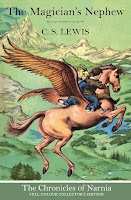 |
| (Amazon UK link) |
However, since I’m familiar with all the stories, I prefer to reread them chronologically. That means starting with ‘The magician’s nephew’, which I last read in 2012. I knew, of course, that it concerned the creation of Narnia, and that the two main protagonists are children called Polly and Digory who live next door to each other in London. It’s set, I understand, in the summer of 1900.
Polly has lived in London all her life, but Digory is there because his father is abroad and his mother is very ill. So they have come to live with his mother’s siblings. His aunt is hard-working and likeable, but his uncle is rather a scary character. He works in the top floor of the house, in a locked room, and barely speaks to Digory.
Digory is rather bored, as well as worried about his mother who seems to be getting worse. Then he discovers that he can explore the attic space above his house. He and Polly join forces, hoping to get into an empty neighbouring house… and end up in the forbidden locked study where Digory’s uncle works. The uncle decides to use the children for an experiment, making them vanish. This uses magical rings. He does also give them other rings that should enable them to return, since he wants to hear what happens. He has no wish to travel himself, but sees nothing amiss in manipulating children…
They find themselves in a peaceful place which they later dub the ‘wood between the worlds’, and discover a series of pools that take them elsewhere. They have an adventure where Digory does something very foolish, and end up back in London with a most unpleasant additional person… Digory’s uncle has to deal with this, and after some quite amusing antics they end up in Narnia, just as it’s coming to life.
I had forgotten that in several places there are asides or comments that are humorous, and I almost chuckled aloud a couple of times. The characters are very well formed, and I could imagine Digory and Polly quite easily. I love the way the author mentions that they squabble, but says that the details of the argument are not worth including. Digory’s uncle, of course, is a caricature; I found him a bit frightening when I was younger, but now he just seems like a highly eccentric self-centred scientist who’s become almost narcissistic in his desire for what he calls ‘progress’.
Perhaps the book was an afterthought for CS Lewis, to fill in some gaps. Digory, we learn at the end, has a small part to play in one of the later books. I know I appreciated that link the first time I read the book, over fifty year ago, and also the explanation about why there were gateways to Narnia in the future. But I also very much like seeing how Narnia started, how fertile it is at the beginning, and why there are some talking animals who are different from the ordinary ones.
These books are written with a Christian worldview, and there are some clear allegorical allusions to the Christian belief in creation. There are also many hints as to who Aslan represents, particularly in his conversations with the delightful London cabbie Frank, who also ends up in Narnia. I love these references, but they're so low-key that they could easily be missed or ignored by anyone of a different faith, or none at all. These books are primarily excellent literature rather than trying to preach.
I hadn’t thought of this as one of my favourites of the series, so was pleased about how very much I enjoyed it. I was also a bit surprised that I had forgotten the low-key humour that pervades so much of it. It’s a happy book, on the whole, despite the underlying story of Digory’s mother’s illness, and despite the evil that is present in Narnia almost from the start.
Suitable for children from the age of about eight or nine, as well as teenagers and adults of any age. Ideal as a read-aloud. Since there are some cultural references to British society at the start of the 20th century, some young children might not understand all the words or concepts, so it can help having someone to answer any questions that might arise.
Highly recommended, but not until you have read at least ‘The lion, the witch and the wardrobe’, and preferably two or three more of the Narnia series. This book was first published in 1955 but, like the others in the series, remains almost continually in print in different editions. I hope they make it into a film, although it seems to have been neglected so far.
Review copyright 2025 Sue's Book Reviews
No comments:
Post a Comment